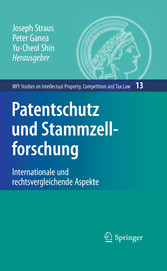Suchen und Finden
Mehr zum Inhalt

Patentschutz und Stammzellforschung - Internationale und rechtsvergleichende Aspekte
Vorwort
6
Inhaltsübersicht
14
Verzeichnis der Herausgeber und Autoren
15
A Study on the Patentability of Inventions relatedto Human Embryonic Stem Cells in Korea
16
1 Historical Background of Biopatenting and its LegislationSystem
16
1.1 Promotion of Biotechnology and Biopatent in Korea
16
1.2 Legislation System
17
2 Unpatentable Subject Matter of Biotechnological Invention
17
2.1 Microorganism Invention
17
2.2 Animal Invention
18
2.3 Genetic Engineering Invention
19
3 Patentability of inventions related to Embryonic Stem Cell(ESC) research
20
3.1 Ethical rule for ESC inventions
20
3.2 Major provisions of “Bioethics and Biosafety Act” related ESCresearch
21
3.2.1 The Establishment of National Bioethics Committee and InstitutionalReview Boards
21
3.2.2 Prohibition on Human Cloning and the Transfer of Embryos between TwoDifferent Species
21
3.2.3 Producing Embryos
21
3.2.4 Research on Remaining Embryos
21
3.2.5 Somatic Cell Embryo Clones
22
3.2.6 Interim Measures on Embryo & ESC Research
22
4 Future Aspects Related to Patentability Issues of Human ESCResearch
22
Patentierbarkeit der Forschungsergebnisse imZusammenhang mit human-embryonalen Stammzellen,insbesondere mit dem sog. therapeutischen Klonen –Aspekte des deutschen und europäischen Rechts
25
1 Institutioneller und rechtlicher Rahmen
26
1.1 Institutionelles Gefüge
26
1.2 Normatives Geflecht
28
1.2.1 EG-zentriertes Biopatentrecht
28
1.2.2 Normativer Wertehorizont für die Auslegung und Anwendung desBiopatentrechts
30
2 Grundlagen des europäischen und deutschen Biopatentrechtsfür die Patentierbarkeit auf dem Gebiet der humanembryonalenStammzellforschung und des therapeutischenKlonens
32
2.1 Eröffnung des Anwendungsbereichs
32
2.2 Geltung der allgemeinen Patentierungsvoraussetzungen
33
2.3 Ethisch motivierte Patentierungsausschlüsse
35
2.3.1 Vorbemerkungen zum Verhältnis von Ethik und Patentrecht
35
2.3.2 Regelungssystematik der ethisch motivierten Patentierungsausschlüsse
36
2.3.3 Grundsätze für die Auslegung und Anwendung der ethisch motiviertenPatentierungsausschlüsse
37
3 Patentierbarkeit auf dem Gebiet der human-embryonalenStammzellforschung
44
3.1 Human-embryonale Stammzellen, Stammzellkulturen oderStammzelllinien als solche
44
3.1.1 Vorliegen der allgemeinen Patentierungsvoraussetzungen
44
3.1.2 Eingreifen ethisch motivierter Patentierungsausschlüsse
46
3.2 Verfahren zur Gewinnung human-embryonaler Stammzellen
63
3.3 Verfahren unter Verwendung human-embryonaler Stammzellen,daraus hervorgehende Erzeugnisse und deren Verwendungen
64
3.3.1 Vorliegen der allgemeinen Patentierungsvoraussetzungen
64
3.3.2 Eingreifen ethisch motivierter Patentierungsausschlüsse
65
4 Therapeutisches Klonen
72
4.1 Verfahren des therapeutischen Klonens
72
4.1.1 „Verfahren zum Klonen von menschlichen Lebewesen“(Art. 6 Abs. 2 lit. a BioPatRL, R. 28 lit. a AO, § 2 Abs. 2 Satz 1 Nr. 1 PatG)
72
4.2 „Therapeutischer Klon“ als solcher
77
5 Schlussbemerkung
77
Patentability of Research Results in Connection withHuman-Embryonic Stem Cells, especially with theSo-Called Therapeutic Cloning – Chinese Points ofView
78
1 Public Awareness and Concern
78
2 Legal Position with regard to the so-called TherapeuticCloning
79
2.1 Chinese Viewpoints with respect to the United Nations Declarationon Human Cloning
79
2.2 Current Status of Therapeutic Cloning Research in China
80
2.3 Related legislation and policy-making
81
2.4 Comments on the American View
81
3 Patentability of the Research Results in Connection withHuman-embryonic Stem Cells
81
3.2 Article 25 of Patent Law and related Patent Examination Guides
82
3.3 Patentable Subject Matter from Therapeutic Cloning ResearchResults
83
3.3.1 Processes and equipment for the extraction of the nucleus from somaticstem cells
83
3.3.2 Ambient conditions for the fertilized ovum to develop into an embryo
84
3.3.3 Processes and equipment for obtaining stem cells from human embryos
84
3.3.4 Processes and equipment for further development of stem cells
84
3.3.5 Processes and equipment for transplantation
84
4 Ethical Rules for Human-embryonic Stem Cell Cloning
85
Die Regelung der Patentierung von Erfindungenmit embryonalen Stammzellen in der Schweiz,in Frankreich, in Österreich und in Italien
86
1 Einleitung
86
2 Zur Schweiz
87
2.1 Verfassungsvorgaben
87
2.2 Legislatorische Umsetzung
88
2.2.1 Fortpflanzungsmedizingesetz
88
2.2.2 Der Umgang mit überzähligen Embryonen
89
2.2.3 Stammzellenforschungsgesetz
90
2.3 Teilrevision des schweizerischen Patentgesetzes
91
2.3.1 Revision im Rahmen des Stammzellenforschungsgesetzes
91
2.3.2 Revision vom 22. Juni 2007
93
2.3.3 Würdigung
98
3 Frankreich
98
3.1 Regelungen zur Forschung an Embryonen und embryonalenStammzellen
98
3.2 Novellierung des Code de la propriété intellectuelle
100
4 Österreich
101
4.1 Novelliertes Patentgesetz vom 9. Juni 2005
101
4.2 Würdigung der österreichischen Umsetzung der Richtlinie 98/44/EG
102
5 Italien
103
5.1 Novellierung vom 22. Februar 2006
103
5.2 Würdigung der italienischen Umsetzung der Richtlinie 98/44/EG
105
6 Schlussbetrachtungen
106
Anhang I
106
Anhang II
108
Aspekte des britischen, amerikanischen, kanadischenund australischen Rechts
110
1 Einleitung
110
2 Großbritannien
111
2.1 Bekanntmachung des UK Patent Office
112
2.2 Kritikpunkte
112
3 USA
113
3.1 Das „Weldon Amendment“
113
3.2 Bewertung
114
4 Kanada
115
4.1 Die CIPO-Richtlinien
115
4.2 Generierung extraembryonaler Gewebe
115
4.3 Organe und Gewebe
116
5 Australien
117
5.1 Entwicklung des australischen Patentrechts
117
5.2 Rahmenbedingungen des Biomedizinrechts
119
6 Zusammenfassende Schlußbemerkung
123
The Issues Surrounding Patent Protection forHuman-Embryonic Stem Cells and TherapeuticCloning in Japan
124
1 Introduction
124
2 Research on Human ES Cells in Japan
125
3 Regulations in Japan
125
4 Patentability Questions
127
4.1 Inventions that contravene public order, morality or public health–Article 32 of the Japanese Patent Law
127
4.2 Debate on Reforming the System for Patent Protection of MedicalActivities
129
4.2.1 Key Court Decision that Gave Momentum to the Debate13
129
4.2.2 Discussions Directed Towards Institutional Reforms
131
4.2.3 Starting Points for Future Discussions
132
5 Conclusion
133
Alle Preise verstehen sich inklusive der gesetzlichen MwSt.








